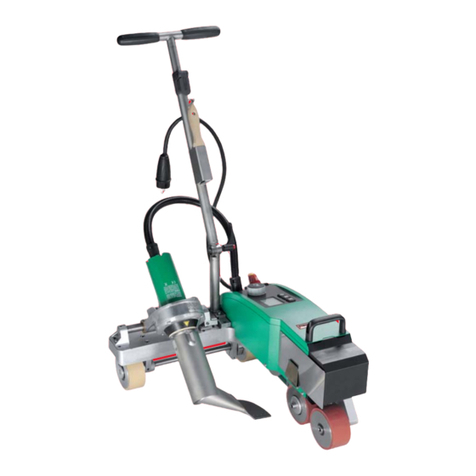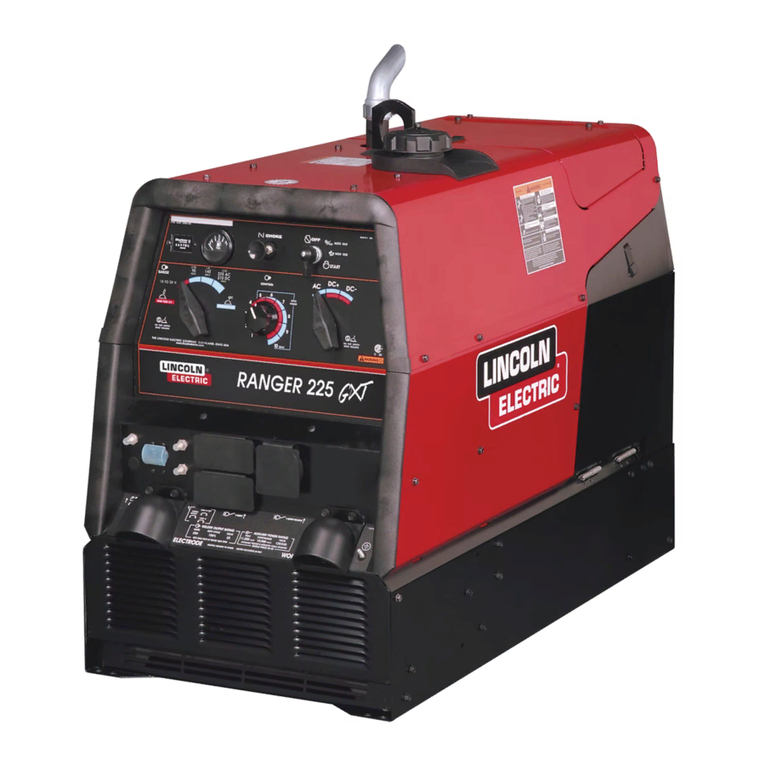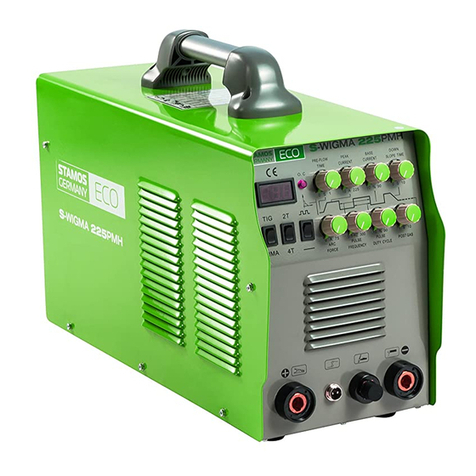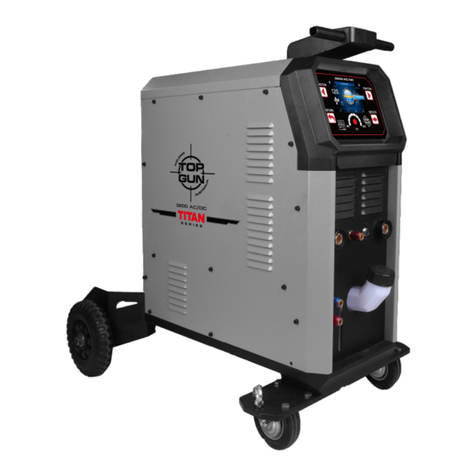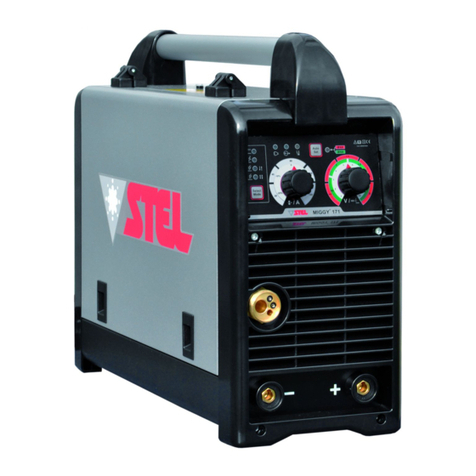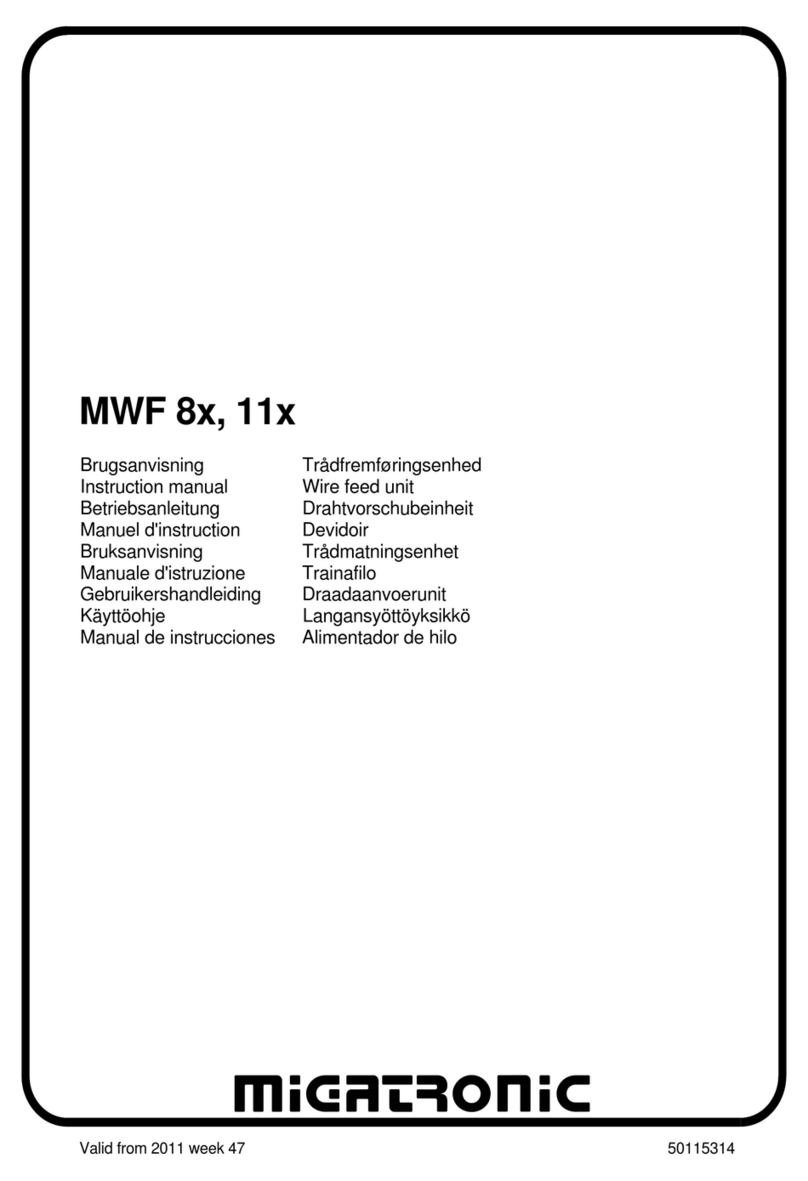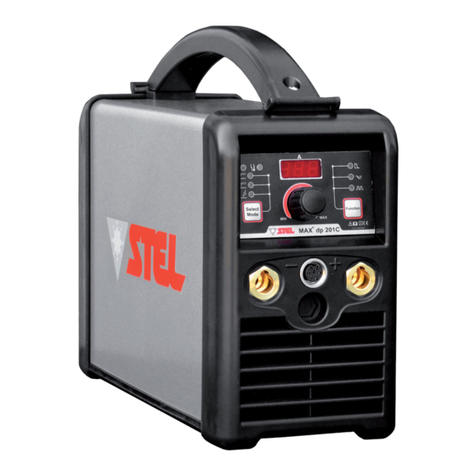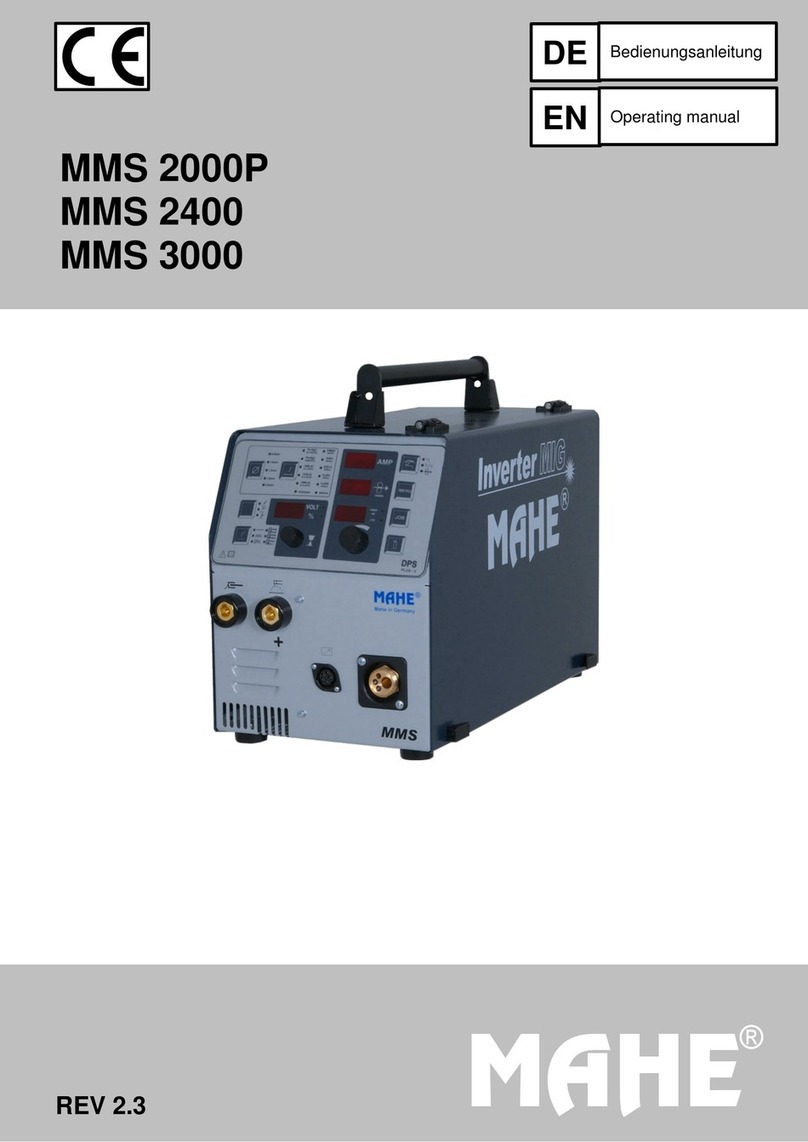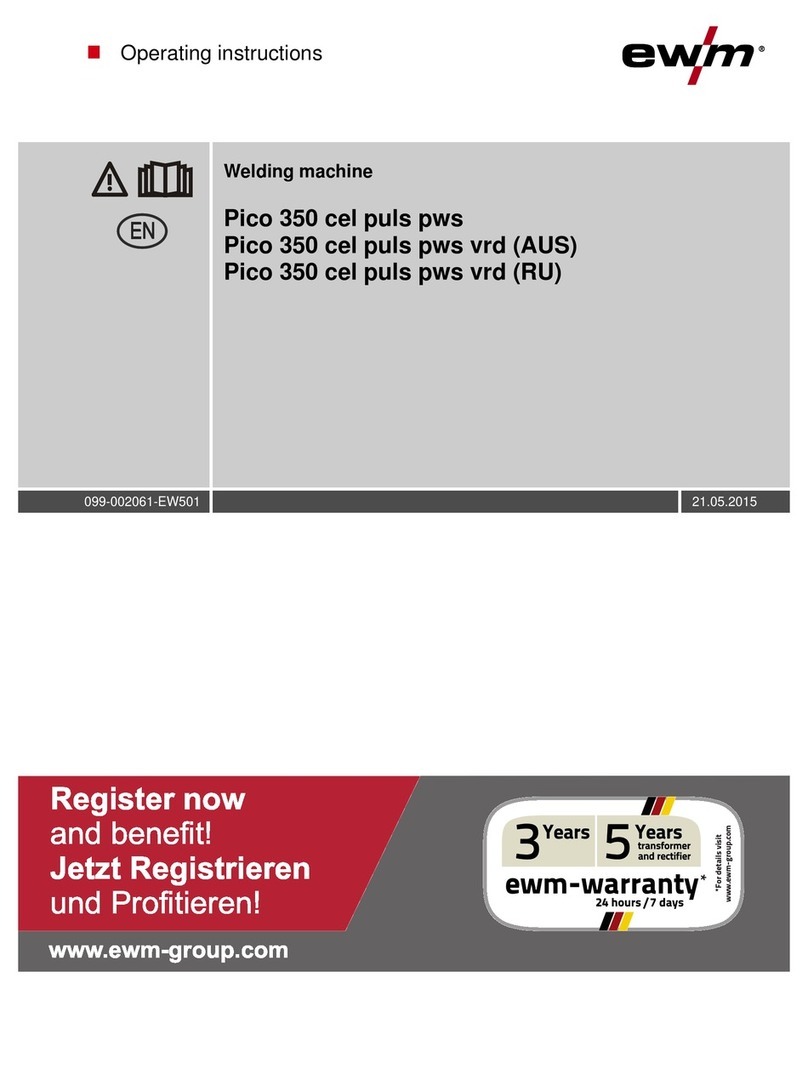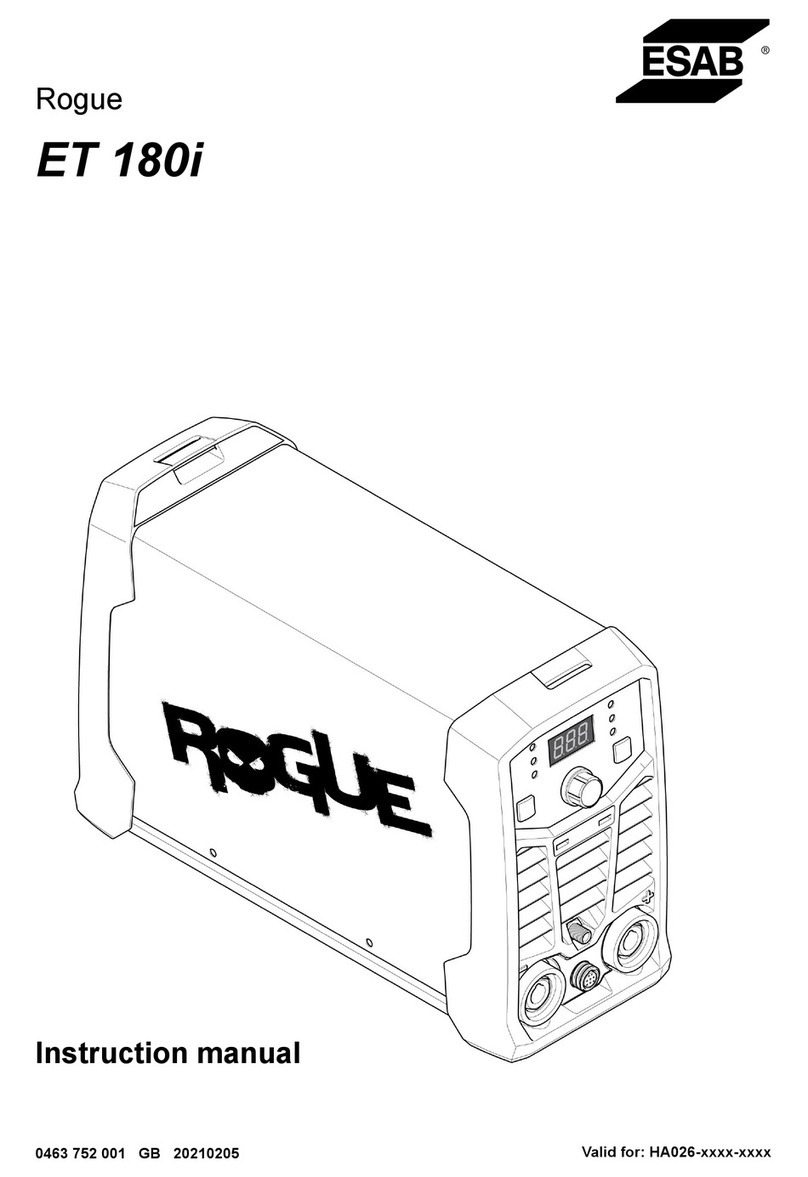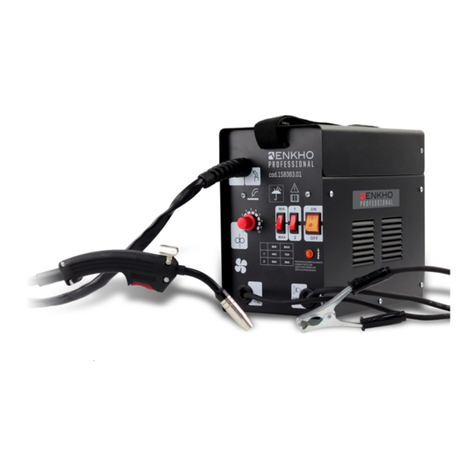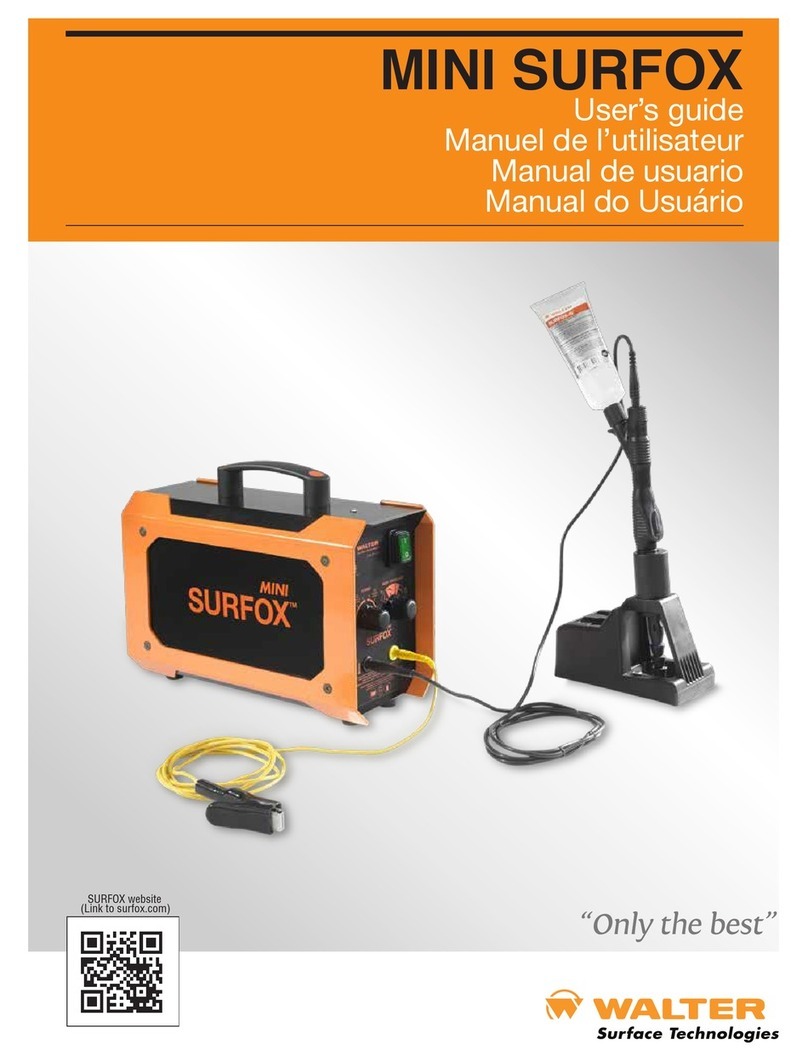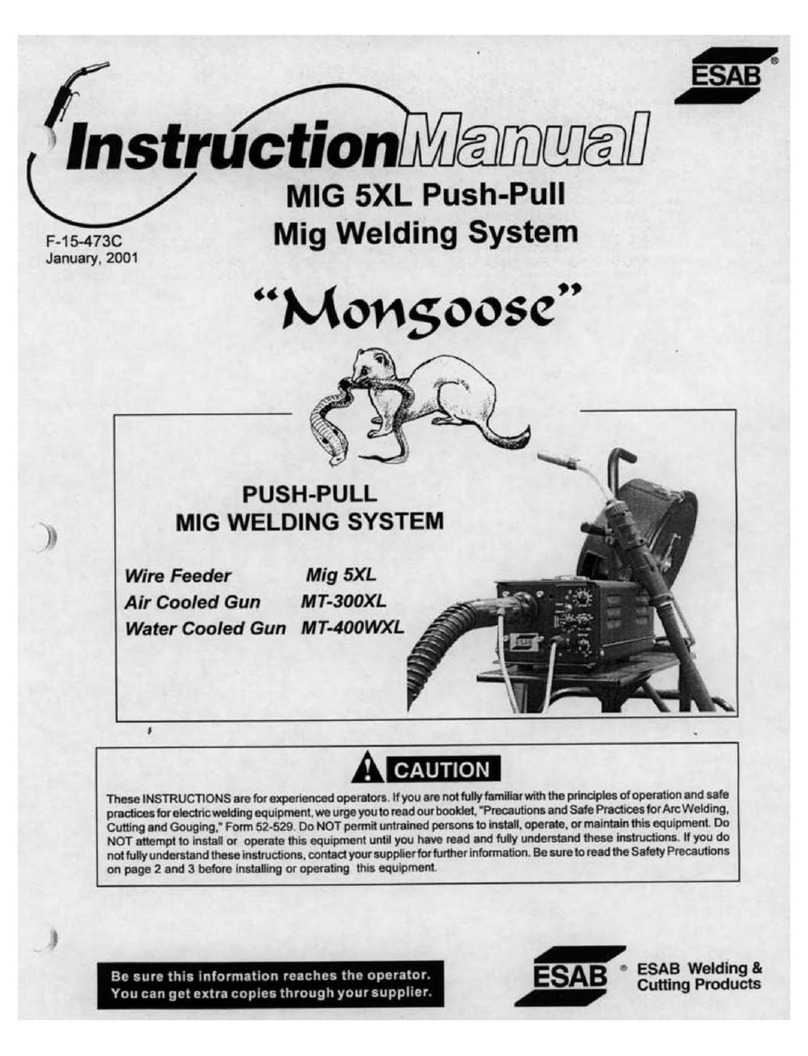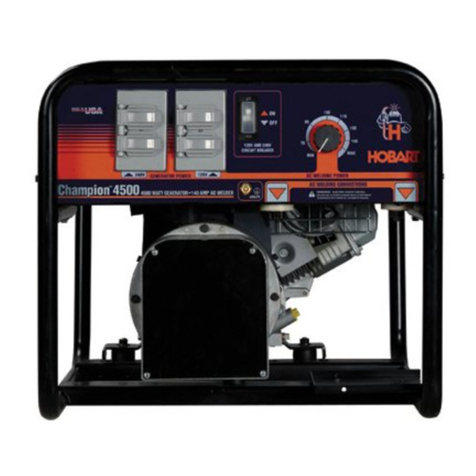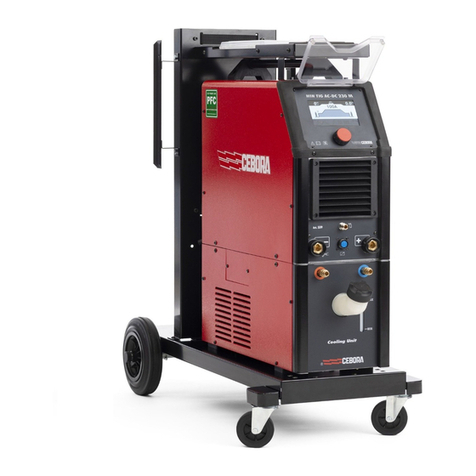Jefferson JEFMIG185-A User manual

User Manual
v.1.1
JEFMIG185-A JEFMIG210-A


3
USER MANUAL
JEFMIG185-A – JEFMIG210-A
185A MIG WELDER - 230V 50Hz
210A MIG WELDER - 230V 50Hz
www.jeffersontools.com
1. Contents
Important: Please read all these instructions before operating this product and save these instructions. This manual has been
compiled by Jefferson Tools and is an integrated part of the product with which it's enclosed and should be kept with it for the
future reference.
This manual describes the purpose for which the product has been designed and contains all the necessary information to ensure
its correct and safe use. We recommend that this manual is read before any operation or, before performing any kind of adjustment
to the product and prior to any maintenance tasks. By following all the general safety instructions contained in this manual you will
help to ensure operator safety and extend the potential lifespan of the equipment.
All photographs and drawing in this manual are supplied by Jefferson Tools to help illustrate the operation of the product. whilst
every effort has been made to ensure accuracy of information contained in this manual our policy of continuous improvement
determines the right to make modifications without prior warning.
1. Contents 3
2. Introduction & Specification 4
3. Safety Guidelines 4
4. Assembly 7
5. Equipment Overview 10
6. Ratings Plate 11
8. Preparation 10
7. MIG / MAG Welding 12
8. Operation Guidelines 13
9. Maintenance 14
10. Troubleshooting 15
11. Parts Diagram & Listing 16
Limited Warranty Statement 18
EC Declaration of Continuity 20
Notes 21

4
USER MANUAL
JEFMIG185-A – JEFMIG210-A
185A MIG WELDER - 230V 50Hz
210A MIG WELDER - 230V 50Hz
www.jeffersontools.com
IMPORTANT: These instructions contain the information you require to prepare your machine for welding, together with a
maintenance and a troubleshooting section. The instructions are not intended to teach you how to weld. If you have no
experience, we recommend that you seek training from an expert source. MIG welding is relatively easy, but does require a steady
hand and supervised practice on scrap metal, as it is only with continued practice that you will achieve the desired results.
INTRODUCTION: Our professional
range of autoMIG welders all feature a
heavy-duty high output transformer and
forced air cooling to maximise duty cycle
performance. AutoMIG 185 and 210 is
supplied with a high quality cool running
BINZEL® Euro torch thus ensuring a
steadier weld bead, 2mtr earth cable,
1.4mtr gas hose, twin gauged gas regulator.
1kg spool of 0.6mm wire, 0.6 and 0.8 tips.
Both units are supplied set up in gas mode,
but can also easily be switched to gasless
mode by a simple change of polarity. Use
in gasless mode will require the purchase
of a spool of uxed cored wire, a pack of
1.0mm tips and a 1.0mm wire feed roller.
*Duty cycle is the ratio of the uninterrupted on-load duration to the total time (10 minutes in this case). It lies between a range of
0 and 1, and can be expressed as a percentage. For example, in the case of a 60% duty cycle, a load is applied continuously for
6 min followed by a no-load period of 4 min.
Model Number JEFMIG185-A JEFMIG210-A
Input Voltage 230V 1ph
Frequency 50Hz
Output Current Range 35-180A 45-210A
Rated Duty Cycle* 100% @ 70A, 15% @ 180A 100% @ 80A, 15% @ 210A
Absorbed Power 5.4kW 7.2kW
Gas Type CO2 / Argon Mix & Argon & CO2
Wire Capacity Steel 5-15kg
Net Weight 43.5kg 45.5kg
Box Dimensions 800 x 460 x 686mm
Cooling System Forced Air
Torch Euro Non Live - BINZEL® ERGO 15.2
2. Introduction & Specification
3.1. ELECTRICAL SAFETY
• WARNING! It is the user’s responsibility to read, understand and comply with the following:
You must check all electrical equipment and appliances to ensure they are safe before using. You must inspect power supply leads,
plugs and all electrical connections for wear and damage. You must ensure the risk of electric shock is minimised by the installation
of appropriate safety devices. An RCCB (Residual Current Circuit Breaker) should be incorporated in the main distribution board. We
also recommend that an RCD (Residual Current Device) is used with all electrical products. It is particularly important to use an RCD
together with portable products that are plugged into an electrical supply not protected by an RCCB. If in doubt consult a qualied
electrician. You may obtain a Residual Current Device by contacting your Jefferson dealer. You must also read and understand the
following instructions concerning electrical safety.
3.1.1. The Electricity At Work Act 1989 requires all portable electrical appliances, if used on business premises, to be tested by a
qualied electrician, using a Portable Appliance Tester (PAT), at least once a year.
3.1.2. The Health & Safety at Work Act 1974 makes owners of electrical appliances responsible for the safe condition of
the appliance, and the safety of the appliance operator. If in any doubt about electrical safety, contact a qualified
electrician.
3.1.3. Ensure the insulation on all cables and the product itself is safe before connecting to the mains power supply. See 3.1.1. &
3.1.2. above and use a Portable Appliance Tester (PAT).
3.1.4. Ensure that cables are always protected against short circuit and overload.
3.1.5. Regularly inspect power supply leads, plugs and all electrical connections for wear and damage and especially power
connections, to ensure that none is loose.
3.1.6. Important: Ensure the voltage marked on the appliance matches the power supply to be used and that the supply is
correctly fused.
3. Safety Guidelines

5
USER MANUAL
JEFMIG185-A – JEFMIG210-A
185A MIG WELDER - 230V 50Hz
210A MIG WELDER - 230V 50Hz
www.jeffersontools.com
3.1.7. DO NOT pull or carry the powered appliance by its power supply lead.
3.1.8. DO NOT pull power plugs from sockets by the power cable.
3.1.9. DO NOT use worn or damaged leads, plugs or connections. Immediately replace or have repaired by a qualied electrician.
A U.K. 3 pin plug must be tted according to the following instructions. (UK only - see diagram at right).
Ensure the unit is correctly earthed via a three-pin plug.
a) Connect the green/yellow earth wire to the earth terminal ‘E’.
b) Connect the brown live wire to live terminal ‘L’.
c) Connect the blue neutral wire to the neutral terminal ‘N’.
d) After wiring, check that there are no bare wires, that all wires have been correctly connected, that the cable
external insulation extends beyond the cable restraint and that the restraint is tight.
3.1.10. JEFMIG185-A and JEFMIG210-A are single phase machines and must be run from a minimum 16amp supply. To
achieve maximum output these models will require a 30amp fused supply. We recommend you discuss the
installation of an industrial round pin plug and socket with your electrician.
Fit a plug according to the following instructions (UK only).
a) Connect the GREEN/YELLOW earth wire to the earth terminal ‘E’.
b) Connect the BROWN live wire to the live terminal ‘L’.
c) Connect the BLUE neutral wire to the neutral terminal ‘N’.
d) After wiring, check that there are no bare wires, that all wires have been correctly connected, that the cable outer
insulation extends beyond the cable restraint and that the restraint is tight.
3.1.11. When a cable extension reel is used it should be fully unwound before connection. A cable reel with an RCD tted
is recommended since any product which is plugged into the cable reel will be protected. The cross-section of
the cable on the cable reel must be suitable for the unit and never lower than the cross-section of the mains cable
supplied with the unit.
3.2. ELECTROMAGNETIC INTERFERENCE
This equipment is fully tested and compliant with EC Directive 2014/30/EU: Electromagnetic Compatibility (EMC) regulations,
however it is important that the user takes responsibility when using the equipment to ensure that electromagnetic disturbances
are minimised or prevented.
Before using the welding equipment you should make an assessment of potential electromagnetic problems in the working
environment. Examples of unsuitable working environments include:
a) areas where other supply cables, control cables, signalling and telephone cables are present
b) in the vicinity of radio and television transmitters and receivers;
c) near computers and other control equipment;
d) areas where medical or safety equipment are present (for example pacemakers and hearing aids etc)
e) environments containing equipment used for calibration or measurement;
Please note: Electromagnetic interference can be caused by devices outside the immediate working environment and
neighbouring rooms and buildings should be assessed for potential issues prior to work commencing.
3.3. ENVIRONMENTAL CONDITIONS
Note: Ambient air should be free from abnormal amounts of dust, acids, corrosive gases or substances etc. other than those
generated by the welding process itself:
• Working ambient air temperature range: -10°C (to) +40°C
• Ambient air temperature range for transport and storage: -25°C (to) +55°C
• Relative humidity: up to 50% at 40°C and 90% at 20°C
• Altitude above sea level up to 1000m.

6
USER MANUAL
JEFMIG185-A – JEFMIG210-A
185A MIG WELDER - 230V 50Hz
210A MIG WELDER - 230V 50Hz
www.jeffersontools.com
3.4. GENERAL SAFETY
DANGER! Unplug the welder from the mains power supply before performing maintenance or service.
• Keep the welder and cables in good condition. Take immediate action to repair or replace damaged parts.
• Use genuine parts and accessories only. Unapproved parts may be dangerous and will invalidate the warranty.
• Use an air hose to regularly blow out any dirt from the liner and keep the welder clean for best and safest performance.
• Check and spray the gas cup and contact tip regularly with anti-spatter spray which is available from your Jefferson dealer.
• Locate the welder in a suitable work area. Ensure that the area has adequate ventilation as welding fumes are harmful.
• Keep work area clean, tidy and free from unrelated materials. Also ensure that the work area has adequate lighting and that a
re extinguisher is at hand.
WARNING! Use welding head shield to protect eyes and avoid exposing skin to ultraviolet rays given off by electric arc.
Wear safety welding gauntlets.
• Remove ill tting clothing, remove ties, watches, rings and other loose jewellery and contain long hair.
• Ensure that the workpiece is correctly secured before operating the welder.
• Avoid unintentional contact with workpiece. Accidental or uncontrolled use of the torch may be dangerous and will wear
the nozzle.
• Keep unauthorised persons away from the work area. Any persons working within the area must wear protective head shield
and gloves.
• Operators must receive adequate training before using the welder.
• Stand correctly, keeping a good footing and balance, and ensure that the oor is not slippery. Wear non-slip shoes.
• Turn voltage switch to OFF when not in use.
• DO NOT operate the welder if it or its cables are damaged and DO NOT attempt to t any unapproved torch or other parts to
the welder unit.
• DO NOT get welder wet or use in damp or wet locations or areas where there is condensation.
DANGER! DO NOT weld near inflammable materials, solids, liquids, or gases, and DO NOT weld containers or pipes which
have held flammable materials or gases, liquids or solids. Avoid operating on materials cleaned with chlorinated solvents
or near such solvents.
• DO NOT stand welder on a metal workbench, car bodywork or similar object.
• DO NOT touch any live metal parts of the torch or electrode while the machine is switched on.
• DO NOT pull the welder by the cable or the torch and DO NOT bend or strain cables. Protect cables from sharp or abrasive
items and DO NOT stand on them. Protect from heat. Long lengths of slack must be gathered and neatly coiled. DO NOT
place cables where they could endanger other people.
• DO NOT touch the torch or workpiece immediately after welding as they will be very hot. Allow to cool.
• DO NOT operate welder while under the inuence of drugs, alcohol or intoxicating medication, or if tired.
• When not in use store the welder in a safe, dry, childproof area.
3.5. GAS SAFETY
• Store gas cylinders in a vertical position only and ensure the storage area is correctly secured.
• DO NOT store gas cylinders in areas where the temperature may exceed 50°C. DO NOT use direct heat on a cylinder. Always
keep gas cylinders cool.
• DO NOT attempt to repair or modify any part of a gas cylinder or valve and DO NOT puncture or damage a cylinder.
• DO NOT obscure or remove any ofcial labels on a cylinder. Always check the gas identity before use. Avoid getting gas
cylinders oily or greasy.
• DO NOT lift a cylinder by the cap, guard or valve. Always keep caps and guards in place and close valve when not in use.
3. Safety Guidelines (continued)

7
USER MANUAL
JEFMIG185-A – JEFMIG210-A
185A MIG WELDER - 230V 50Hz
210A MIG WELDER - 230V 50Hz
www.jeffersontools.com
4.1 ASSEMBLING THE WHEELS: (Refer to g.1) The wheels are more
easily assembled with the welder placed upside down on a smooth
non-abrasive surface. The welder should be turned over by two
people as it is very heavy.
4.1.1 Bolt the two castors (1) to the front end of the base (2) using the
bolts provided.
4.1.2 Take the solid axle (3) and slide a wheel (4) over one end followed by
a washer (5). Insert a split pin (6) through the hole in one end of the
axle as shown below and bend it over.
4.1.3 Take an axle retaining bracket (7) and insert it into the slots in the
base (2). Hold the bracket in place and slide the axle assembly
through both parts of the bracket. Insert the second axle retaining
bracket (7) through the base and continue to slide the axle across so
that it passes through the second bracket and holds the wheel (4)
up against the side of the base. Slide the second wheel (8) onto the
free end of the axle followed by a washer (9). Retain the entire axle
assembly by passing a split pin (10) through the free end of the axle
and bend it over to retain the whole axle assembly.
4.1.4 With the assistance of another person turn the welder the right way
up onto its wheels.
4.2 ASSEMBLING THE HANDLE: (Refer to g.2) On the front of the
welder there are two pairs of threaded inserts, one pair in the top
left corner and one pair in the top right hand corner..
4.2.1 Attach the left hand handle mounting (1) to the front of the welder
using two of the 25mm round headed bolts provided. Do not fully
tighten yet.
4.2.2 Slide the handle tube (2) into the socket in the mounting and push
fully home.
4.2.3 Slide the socket on the right hand handle mounting (3) over the free
end of the handle tube and rotate the mounting downwards until it
is resting on the front of the welder. Using two of the 25mm round
headed bolts provided to x the right hand mounting in place.
4.2.4 Now fully tighten all four xings.
4.3 ASSEMBLING THE EARTH CLAMP: (Refer to g.3) Feed the
eyelet on the end of the earth lead through the hole in the clamp
arm as shown in g.3A.
4.3.1 Drop the eyelet over the terminal and rmly x with the bolt
provided as shown in g.3B.
4.4 INSTALLING THE GAS CYLINDER. The welder is designed
to accommodate small or medium sized gas cylinders up to a
maximum height of 1000mm. Contact your local Gas dealer
for supply.
4.4.1 Place the gas cylinder onto the rear platform of the welder. Drop
one end of the xing chain into one side of the retaining bracket.
Draw the chain around the cylinder and place it into the slot on
the other side of the bracket leaving as little slack in the chain
as possible.
4.5 ATTACHING THE REGULATOR. Whichever gas you are using
it is advisable to 'crack' the cylinder valve before attaching the
regulator. This means opening and closing the valve very quickly in
order to blow away any dust and dirt that may have accumulated
in the gas outlet. Stand to one side whilst doing this.
4.5.1 CO² GAS. Ensure that the threads on the gas bottle are
undamaged and free of oil and grease before attaching the
regulator. (Oil or grease in the presence of high pressure gases
can be explosive.) E Ensure that the regulator has an undamaged
gasket tted. The regulator will screw directly to the threads on the
gas bottle. Tighten with a spanner.
4. Assembly
FIG. 1
FIG. 4
FIG. 2
FIG. 3

8
USER MANUAL
JEFMIG185-A – JEFMIG210-A
185A MIG WELDER - 230V 50Hz
210A MIG WELDER - 230V 50Hz
www.jeffersontools.com
4.5.2 ARGON GAS OR ARGON MIXTURES. Cylinders containing
Argon gas and Argon mixtures have a female thread and will
require the use of a Bull Nose Adaptor to attach the regulator
to the cylinder as indicated in g.4. Ensure that the threads on
the gas bottle are undamaged and free of oil and grease before
attaching the regulator. (Oil or grease in the presence of high
pressure gases is explosive.) Fit the Bull Nose Adaptor to the
cylinder rst and tighten with a spanner. Ensure that the regulator
has an undamaged gasket before tting onto the Bull Nose
Adaptor. Tighten with a spanner.
4.5.3 Slide a jubilee clip over each end of the gas hose supplied. Push
one end of the hose onto the regulator outlet and the other end
over the gas inlet spigot on the back of the welder. Tighten the
clips to ensure a good seal.
4.5.4 Close the regulator valve by turning it anticlockwise before
opening the cylinder valve. Stand to one side when opening the
cylinder valve.
4.5.5 Set the regulator ow rate to 5-8 litres/min depending on the
material to be welded, and whether there are draughts which are
strong enough to disturb the gas ow.
4.6 CONNECT THE TORCH CABLE TO THE WELDER. Align the
pins on the Euro connector with the socket on the welder front
panel as shown in g.5. Push the connector into the socket and
rotate the locking ring (A) clockwise so that it draws the plug
into the socket as shown in g.6. Note: damage to torches and
cables is not covered by warranty.
4.7 FITTING A REEL OF WIRE. These units will accept either a 5kg or
a 15kg reel of wire. Ensure that the wire diameter used is matched
by the correct groove size in the drive wheel and the correct tip
size on the torch as well as the correct torch liner. Failure to do
this could cause the wire to slip and/or bind.
4.7.1 Unscrew the locking knob from the end of the spool holder (see
g.7) and remove the spacer. Slide the reel of wire onto the spool
holder and ensure that the clutch pin at the back of the spool
holder engages into the guide hole in the wire reel moulding. This
will prevent the wire reel from freewheeling on the spool holder.
When using a 5kg reel, slide the spacer onto the spool holder
before rexing the locking knob. Ensure that the wire is coming off
the top of the reel in the direction of the wire drive unit as shown in
g.8 which shows a 15kg reel of wire in place on the spool holder.
4.8 FEED WIRE THROUGH TO TORCH. Open the wire feed
mechanism by pushing the locking/wire tension knob (1) down
to the right allowing the pressure roller carrier (2) to spring up
revealing the feed roller as shown in g.9. Ensure that the required
feed groove (0.6 or 0.8) is in line with the wire path. See Section
3.12 on how to reverse or change the roller.
4.8.1 Release the wire from the reel and cut off any bent portion
ensuring that there are no burrs left on the end of the wire. Keep
the wire under tension at all times to prevent it uncoiling.
4.8.2 Straighten about 40-50mm of wire and gently push it through the
exible metal sheathed cable (3) and through the 6 or 8mm feed
roller groove and on into the torch cable liner.
4.8.3 Push down the pressure roller carrier onto the wire feed roller and
hold it down. Lift up the locking/wire tension knob so that it enters
the slot in the pressure roller carrier and snaps into the indent in
its top surface. See g.11. Rotate the tension knob to a medium
setting i.e. between 2 and 3.
4.8.4 Remove gas cup (g.10-2) and contact tip (1) from end of torch as
follows: a) Take torch in left hand with the torch tip facing to the
right. b) Grasp gas cup rmly in your right hand. c) Turn gas cup
clockwise only and pull it off end of torch tip.
• WARNING! do not turn gas cup anti-clockwise, as this will
FIG. 5
FIG. 6
FIG. 7
FIG. 8
FIG. 9
FIG. 10

9
USER MANUAL
JEFMIG185-A – JEFMIG210-A
185A MIG WELDER - 230V 50Hz
210A MIG WELDER - 230V 50Hz
www.jeffersontools.com
damage the internal spring. d) Unscrew copper contact tip
(right hand thread) to remove.
4.8.5 Check welder is switched off “0”, and that the earth clamp is away
from the torch tip. Connect the welder to the mains power supply
and set the voltage switch to one. 3.9.6 Set the wire speed knob
to position 5 or 6. Keep the torch cable as straight as possible and
press the torch switch. The wire will feed through the torch. 3.9.7
When the wire has fed through, switch welder off, unplug from
mains. a) Take torch in left hand, slide the contact tip over the wire
and screw back into place. b) Grasp gas cup in right hand, push
onto torch head and turn clockwise only. Do not turn gas cup anti-
clockwise, as this will damage the internal spring. c) Cut wire so
that it is just protruding from the cup.
4.9 SETTING WIRE TENSION. Adjust the wire tension by rotating
the wire tension knob. Turn clockwise to increase the tension and
anticlockwise to decrease the tension. See (1) in g11.
IMPORTANT: Too little or too much tension will cause
problematic wire feed and result in poor welding.
4.9.1 Tension between rollers is checked by slowing down the wire
between gloved ngers. If top feed roller skids the tension is
correct. Use as low a tension as possible, too high a tension will
disgure wire and result in a blown fuse.
4.10 CLUTCH ADJUSTMENT. Note: It is essential that the clutch is
adjusted correctly.
4.10.1 Once the wire is fed through the torch, switch on the machine and
set the wire speed to maximum.
4.10.2 D Depress torch switch and release quickly. If the spool overruns it
indicates that the clutch is too loose.
4.10.3 Tighten the clutch nut located in the centre of the wire spool
holder with a spanner (g.8-C) and test the machine as above until
the wire stops over running.
Note: DO NOT over tighten the clutch as this will cause wire
feed problems and strain the motor.
4.11 TURNING/CHANGING THE DRIVE ROLLER. (See g.12) Ensure
that the wire diameter used, is matched by the correct groove size
in the drive wheel and the correct tip size on the torch as well as
the correct torch liner. Failure to do this could cause the wire to
slip and/ or bind.
4.11.1 Referring to g.9, open the wire feed mechanism by pushing
the locking/wire tension knob (1) down to the right allowing the
pressure roller carrier (2) to spring up revealing the feed roller.
4.11.2 Referring to g.12, loosen and unscrew the black feed roller
retaining knob (C) and put to one side.
4.11.3 The roller carrier (A) is keyed to the main drive shaft and the drive
roller (B) is keyed to the carrier, see below. Place a nger onto the
end of the drive shaft to prevent the carrier moving and slide the
drive roller off the carrier with your other hand.
4.11.4 The size of each wire feed groove is printed on the edge of the roller on the same side as the groove.
4.11.5 Turn the roller over to use the other groove or use a roller with different sized grooves as required. The groove to be used
should be positioned furthest away from you to be in line with the drive path.
4.11.6 Check that the key in the carrier (A) is properly seated in its slot. Ensure that the slot on the inside face of the drive roller
(B) is aligned with the key and slide the roller back onto the carrier.
4.11.7 Screw the black roller retaining knob (C) back on to the end of the drive shaft and tighten.
4.12 CONVERTING TO GASLESS WELDING. When delivered, your welder is set up for gas welding with the torch cable
connected to the positive (+) terminal and the earthing cable connected to the negative (-) terminal.
4.12.1 To weld without gas (using ux cored wire) you must reverse the polarity and connect the torch cable to the negative (-)
terminal and the earthing cable to the positive (+) terminal as shown in g.13.
4.12.1 Ensure that the machine is switched off and unplugged from the mains supply before carring our this task.
4.12.2 Safely disconnect the gas.
4.12.3 Fit a 1.0mm tip to the torch.
4.12.4 Change the drive roller to one having a 1.0mm groove.
4.12.5 Mount the ux cored wire reel and feed it through to the torch.
FIG. 11
FIG. 12
FIG. 13

10
USER MANUAL
JEFMIG185-A – JEFMIG210-A
185A MIG WELDER - 230V 50Hz
210A MIG WELDER - 230V 50Hz
www.jeffersontools.com
The following summary provides a brief overview of the front switch panel (see Fig.14). If you have any additional questions
relating to the equipment please contact your nearest Jefferson Dealer before using the equipment.
5.1. “ON/OFF” switch
When the switch is in the “OFF” position it means power has been shut off to the welder, when the switch is in the ”ON”
position it means power is supplied to the main transformer and control circuit.
5.2. Voltage Setting switch
The voltage setting switch is on the front panel of the machine. There are six settings, allowing you to choose the correct
voltage level for the thickness and type of metal being welded.
5.3. Wire speed control knob
Used to control the wire speed: turn clockwise to increase the wire speed or counter-clockwise to decrease the wire
speed. The numbers (0-10) around the knob show the wire feed speed. The rated wire feed speed for this equipment is
1.8m/min ~ 11.6m/min.
5.4. Overload light
If you are welding with a large current for a long time and exceed the duty cycle, the overload lamp will light (yellow), and
the welder will automatically shut down until it cools down. If this happens, you must stop welding and wait approximately
10 minutes, before the unit will reset and allow you to continue welding.
5. Equipment Overview
Fig.14 Front Switch Panel
OVERLOAD LIGHT
VOLTAGE SETTING
SWITCH
"ON / OFF"
SWITCH
POWER CORD
WIRE SPEED
CONTROL KNOB
WELDING TORCH
SOCKET
GROUNDING
CABLE

11
USER MANUAL
JEFMIG185-A – JEFMIG210-A
185A MIG WELDER - 230V 50Hz
210A MIG WELDER - 230V 50Hz
www.jeffersontools.com
JEFMIG185-A
6. Ratings Plate
On the front panel of the welder is the ratings plate, giving the following data:
1: The BS/EU standard relating to the safety and construction of arc welding and associated equipment.
2: Single phase transformer – rectier.
3: Symbol indicates welding with a continuous ow of welding wire.
4: Symbol for Single-phase AC supply.
5: Rating of internal protection provided by casing.
6: Output U0Rated minimum and maximum no load voltage.
I2, U2Current and corresponding voltage.
X Welding ratio based on a 10 minute cycle.
20% indicates 2 minutes welding and 8 minutes rest,
100% would indicate continuous welding.
7: Mains Supply U1Rated supply voltage and frequency.
I1max Maximum current.
I1eff Maximum effective current.
8: Welding current range.
9: Serial Number. Specically identies each welder.
1
1
9
9
2
2
3
3
4
4
5
5
8
8
6
6
7
7
JEFMIG210-A

12
USER MANUAL
JEFMIG185-A – JEFMIG210-A
185A MIG WELDER - 230V 50Hz
210A MIG WELDER - 230V 50Hz
www.jeffersontools.com
A spool of welding wire is positioned on the welder’s spool holder and automatically
fed through an insulated liner in the torch to the tip. The torch assembly consists of a
switch, liner, gas hose, and control cable. The switch activates the wire feed roller and
the gas ow. Conversely, releasing the switch stops the wire feed and gas ow. The
weld current is transferred to the electrode (the wire) from the contact tip at the end of
the torch. A gas cup ts over the contact tip to direct the gas ow towards the weld
ensuring that the arc welding process is shielded from oxidising air contaminates. The
shielding gas also assists heating of the weld materials. (The welder can also be used
in gasless mode using ux cored wire). The torch is connected to the positive side of
a DC rectier, and the negative clamp is attached to the workpiece.
IMPORTANT: Should you have no welding experience, we recommend you seek
training from an expert source to ensure your personal health & safety. Good
Mig welding may be achieved only with continued, supervised practice.
7. 1 PREPARATION FOR WELDING
IMPORTANT: BEFORE YOU COMMENCE, MAKE SURE THE MACHINE IS
SWITCHED OFF AT THE MAINS. IF WELDING A CAR, DISCONNECT THE
BATTERY OR FIT AN ELECTRONIC CIRCUIT PROTECTOR. ENSURE YOU
HAVE READ & UNDERSTOOD THE ELECTRICAL SAFETY INSTRUCTIONS
IN SECTION 3.
7.1.1 Connecting the Earth Lead.
To ensure a complete circuit, the earth lead must be securely attached to the
work piece that is to be welded.
a) Best connection is obtained by grinding clean the point of contact on the
workpiece before connecting the earth clamp.
b) The weld area must also be free of paint, rust, grease, etc.
c) When welding a vehicle, be sure the vehicle battery is disconnected or t
an Electronic Circuit Protector available from your Jefferson dealer.
7.1.2 Power Output switch. Set the switch to position 1 or 2 for welding up to
2mm thickness. Use settings 3,4,5,6 for thicker welds.
7.1.3 Setting the welder controls. In principle, the lower the amperage required,
the slower the wire speed. See setting chart for voltage and corresponding
wire speeds. Note: these settings are only a guide and will vary according to
the operators experience.
7.1.4 Welding mild steel. To weld mild steel you can use CO² gas for most tasks
where spatter and the high build up of weld do not pose a problem. Welding
with a long arc reduces penetration and widens the arc. This in turn results
in more spatter. A long welding arc can be appropriate for welding butt joints
in thin materials. Welding with a short arc, at the same weld settings, results
in greater penetration and a narrower weld
and reduces the amount of spatter. To
achieve a consistent spatter free and at
weld, you must use an Argon/CO² mixture.
7.1.5 To weld aluminium use:
3Argon gas,
30.8mm Contact Tip (MIG927),
30.8mm Aluminium Wire, (MIG/2KAL08).
7.1.6 Overload Protection. Thermostatic
overload protection is provided. When an
overload has occurred, leave the unit to
cool. The thermostat will automatically reset
the unit when the temperature has returned
within limits
7. MIG / MAG Welding
Settings shown as a guide only
Wire 0.6mm Steel
Argon / CO2Mix
Voltage Step 1 2 3 4 5 6
Wire Speed 5 6 7 8 9 10
Above: Polarity settings for
welding without gas and with gas

13
USER MANUAL
JEFMIG185-A – JEFMIG210-A
185A MIG WELDER - 230V 50Hz
210A MIG WELDER - 230V 50Hz
www.jeffersontools.com
PRECAUTIONS
• Ensure that there is free air circulating around the outer casing of the
welder, and that the air vents are unobstructed.
• Welding arc can seriously damage your eyes. Both the operator and
spectators must always use a suitable welding face shield or helmet, with
suitable lter lenses for the welding processes.
• Suitable Personal Protection Equipment (PPE) including gloves and
working clothes should be worn at all times.
• Always check and ensure that the pressure regulator and gauges (if tted) are working correctly before use.
• Regulators are designed to be used with specic gases, it is important that you use the correct regulator for the gas required.
• Do not lubricate the regulator.
• Inspect gas hoses, cables and clamps before use to ensure they are in good condition.
• Remove all ammable materials from the working environment before use.
• Keep a re extinguisher nearby at all times. The extinguisher should be Dry Powder or CO2type.
• Do not remove any of the casing panels for repair or maintenance unless the machine is disconnected from the supply,
and never use the machine with any of the panels removed. All repairs should be carried out by qualied engineers using
Jefferson approved parts. Contact your nearest Jefferson Dealer for details.
• Never use or store this equipment in a wet or damp environment and do not expose the equipment to rain during use.
• The MIG welding process uses an inert gas to protect the weld pool. It is important to ensure the appropriate gas is being used.
• Never use an unknown or unidentiable gas supply or gas from a damaged or unmarked cylinder.
• Do not lift or move a gas cylinder by holding he cylinder by the valve.
• Do not expose the cylinder to a heat source or sparks while in storage or in use.
• Stop welding immediately if any static / electric shocks are felt or detected. Do not attempt to weld using the equipment until
the source of the fault is identied and repaired.
• Do not point the MIG torch at anyone when in use.
• Do not touch the MIG torch nozzle until the welder is switched OFF and the nozzle has been allowed to cool off.
• Never connect, disconnect, or attempt to service the MIG torch, until the machine is switched OFF and disconnected from
the mains power supply.
• Never allow the equipment cables to become wrapped around the operator or any bystanders in the working environment.
8. Operation Guidelines
Before welding:
• Read and understand the safety rules section of this manual
• Ensure all ammable materials are removed the work area
• Ensure there is good ventilation around the welding unit and the working environment
• Enure you have a re-extinguisher in the vicinity of the working environment and that it is ready for use in the event of re
• Wear appropriate protective clothing and insulated leather gloves (check with your nearest Jefferson Dealer for advice)
Step 1: Connect work clamp onto metal to be welded, or to the metal workbench where the object is mounted and electrically
connected.
Step 2: Before plugging in, adjust the amperage and wire feed speed according to material type and thickness, and the wire size.
Step 3: Check the power switch is in the OFF position, and then plug the power cable into the electrical outlet.
Step 4: While holding the torch with the wire and tip clearly out of the way of any grounded objects, turn the power switch to
ON position.
Step 5: Orient yourself on the area to be welded, and then place the face shield over your eyes.
Step 6: Press (and hold) the torch button and stroke the area to be welded
with the electrode wire to ignite the arc.
Step 7: Once the arc is ignited, tilt the electrode wire forward at an angle of
approximately 35° (as shown in Fig.15).
Step 8: When the weld is complete, release the torch button and lift the wire
clearly away from any grounded object, set the Face Shield down and turn
the Power Switch to the “OFF” position.
Step 9: Unplug the Power Cord from the electrical outlet.
WARNING: WEAR APPROPRIATE PERSONAL PROTECTION EQUIPMENT AT ALL TIMES
Never look at the ignited arc without approved, arc shaded, eye protection in a full-face shield. Permanent
eye damage or blindness can occur. Skin burns can occur. Never breathe arc fumes.
Fig.15 Electrode wire angle

14
USER MANUAL
JEFMIG185-A – JEFMIG210-A
185A MIG WELDER - 230V 50Hz
210A MIG WELDER - 230V 50Hz
www.jeffersontools.com
9. Maintenance
9.1. WIRE FEED UNIT. Check the wire feed unit at regular intervals. The feed roller wire guide plays an important part in
obtaining consistent results. Poor wire feed affects welding. Clean the rollers weekly, especially the feed roller groove,
removing all dust deposits.
9.2. TORCH. Protect the torch cable assembly from mechanical wear. Clean the liner from the machine forwards by using
compressed air. If the liner is clogged it must be replaced.
9.3. CHANGING FEED ROLLER (See Section 3.12)
9.4. CONTACT TIP. The contact tip is a consumable item and must be replaced when the hole becomes enlarged or oval. The
contact tip MUST be kept free from spatter to ensure an unimpeded ow of gas. Refer to g.10 and section 4.8 for removal
and replacement.
9.5. GAS CUP. The gas cup must also be kept clean and free from spatter. Build up of spatter inside the gas cup can cause a short
circuit at the contact tip which will result in either the fuse blowing on the printed circuit card, or expensive machine repairs.
To keep the contact tip free from spatter, we recommend the use of anti-spatter spray available from your Jefferson Dealer.
Refer to g.10 and section 4.8 for removal and replacement.
9.6. REPLACING THE LINER. Wind the wire back on to the spool and secure it. Unscrew the torch from the machine and undo
the brass nut. The liner should now be visible. Pull it out and replace with a new one.
WARNING:
Before performing any maintenance on the Welder, unplug the Power Cable from the electrical outlet and
allow all parts of the welder to cool thoroughly
Parts & Servicing
For Jefferson approved replacement parts contact your
nearest dealer or contact Jefferson tools
Telephone: +44 (0)1244 646 048
Fax: +44 (0)1244 241 191
Email: [email protected]

15
USER MANUAL
JEFMIG185-A – JEFMIG210-A
185A MIG WELDER - 230V 50Hz
210A MIG WELDER - 230V 50Hz
www.jeffersontools.com
WARNING:
Be certain to shut off the welder, disconnect it from power, and discharge the torch to ground before
adjusting, cleaning, or repairing the unit. Electrical repairs should only be made by a trained technician.
Symptom Possible Cause Corrective Action
No output 1. Duty cycle exceeded
2. Poor work clamp connection
3. Blown breaker or fuse
1. Allow welder to cool until lamp goes out
2. Be sure all connections are secure, and attaching surface is clean
3. Reduce circuit load, reset breaker or replace fuse
Wire tangles at
drive roller
1. Wrong size contact tip
2. Torch liner clogged or damaged
3. Contact tip clogged or damaged
4. Drive roller worn
5. Not enough tension
1. Use proper size contact tip
2. Clean or replace wire liner
3. Clean or replace contact tip
4. Replace drive roller
5. Tighten tension knob
Gun nozzle arcs to
work surface
1. Slag inside gun nozzle
2. Insulation ring melted or expired
1. Clean slag from gun nozzle
2. Replace nozzle
Work clamp and/or
cable gets hot
1. Poor contact
2. Using an extension cord with excessive length
1. Be sure all connections are secure, and welding surface is clean
2. Never use an extension cord longer than 20ft
Wire does not feed 1. Wire jammed
2. Out of wire
3. Not enough tension
4. Wire liner worn
5. Contact tip clogged
1. Reload wire
2. Replace wire spool
3. Tighten tension knob if wire is slipping
4. Replace liner
5. Replace contact tip
Weld pops and
sputters
1. Wire speed setting
2. Contact tip size too large
3. Drive roller slipping
1. Tune in correct setting
2. Replace contact tip
3. Increase tension
Weld current
interrupted
1. Overheating protection activated due to overload 1. Protection automatically resets when transformer has cooled
(approximately 15 minutes)
No weld current 1. Rectier blown
2. Bad connection between clamp and workpiece
3. Break in earth lead
4. Break in torch lead
1. Replace rectier
2. Clean or grind contact surface and weld area
3. Repair or replace earth lead
4. Repair or replace torch lead
Feed motor
not working
1. Gear damaged or worn
2. Motor defective
3. PCB fault
1. Replace gears
2. Replace motor (contact service agent)
3. Replace PCB
Wire does not feed.
Feed roller rotates
1. Pressure roller improperly adjusted
2. Dirt, copper, dust, etc. have collected in torch liner
3. Gas cup (nozzle) or tip defective
4. Deformed wire
1. Adjust tension
2. Clean the liner from the machine forward using compressed air
3. Replace gas cup (nozzle) and/or tip. Check roller tension (Sec 6)
4. Adjust roller tension
Wire feeds unevenly 1. Dirt etc. in liner
2. Gas cup (nozzle) or tip defective
3. Gas cup (nozzle) spattered
4. Feed roller groove clogged
5. Feed roller groove deformed
6. Pressure roller tension incorrect
1. Clean the liner from the machine forward using compressed air
2. Replace gas cup (nozzle) and/or tip
3. Clean or replace gas cup (nozzle)
4. Clean feed roller
5. Replace feed roller
6. Adjust tension
Unstable arc 1. Incorrect settings
2. Impurities in weld area
3. Worn or defective gas cup (nozzle)
1. Check settings
2. Clean and/or grind workpiece
3. Replace gas cup (nozzle)
Porous weld 1. No gas
2. Gas cup clogged
3. Draught blowing away shielding gas
4. Rusty/dirty joints
5. Torch too far from, or at wrong angle to, workpiece
6. Gas leak
7. Faulty electrovalve
1. Open gas cylinder, regulate gas ow
2. Clean or replace gas cup (nozzle)
3. Screen off welding site or increase gas ow
4. Clean and/or grind workpiece
5. Gas cup to workpiece should be 8-10mm. Torch angle approx 75°
6. Check hoses, connections and torch assembly. Press gas cup into position
7. Clean out or replace
Electrode sticking
in gas cup (nozzle)
1. Worn or defective gas cup (nozzle)
2. Wire deformed
3. Wire speed too slow
1. Replace gas cup (nozzle)
2. Check roller tension
3. Increase wire speed
Irregular
weld head
1. Torch incorrectly held
2. Wire weaving in weld pool
1. Use correct torch angle
2. Check roller tension and adjust
Weld bead too
narrow and raised
1. Weld current too low
2. Weld speed too fast
1. Increase power and wire speed
2. Move torch more slowly and weave a little more
Weld bead too wide 1. Weld current too high
2. Weld speed too slow
3. Arc too long
1. Increase power and wire speed
2. Move torch more quickly and weave a little less
3. Bring torch closer to workpiece
Poor penetration 1. Weld current too low
2. Arc too long
1. Increase current and wire speed
2. Bring torch closer to workpiece
Excessive
penetration
1. Weld current too high
2. Weld speed too slow
3. Incorrect distance of torch to workpiece
1. Decrease current and wire speed
2. Move torch faster
3. Torch distance should be 8-10mm
10. Troubleshooting

16
USER MANUAL
JEFMIG185-A – JEFMIG210-A
185A MIG WELDER - 230V 50Hz
210A MIG WELDER - 230V 50Hz
www.jeffersontools.com
11. Parts Diagram & Listing
Parts for gas / gasless MIG Welders JEFMIG185-A & JEFMIG210-A
ITEM DESCRIPTION ITEM DESCRIPTION
1 Side Panel 35 Capacitor
2 Valve Assembly 36 Wire Feed PCB
3 Valve Bracket 37 Access Panel
4 Chain 38 Latch
5 Gas Bottle Support 39 Filter Reactor
6 Back Panel 40 Main Transformer
7 Rubber Support 41 Transformer Support
8 Top Panel 42 Rectier Support
9 Hinge 43 Switch
10 Rubber Washer 44 Bottom Panel
11 Nut, M8 45 Castor Wheel
12 Fan 46 Thermal Switch
13 Inner Panel 47 Axle Bracket
14 Resistance 48 Pin
15 Relay 49 Washer
16 Axle 50 Wheel
17 Bolt M8 x 25mm 51 Axle
18 Nut, M10 52 Handle
19 Plastic Knob 53 Handle Support (Right)
20 Spool Holder 54 Torch Holder
21 Spring 55 Speed Control Knob
22 Bolt, M10 x 80 56 Overload Indicator Light
23 Retainer 57 ON/OFF Switch
24 Wire Feed Roller 58 Welding Torch (MB15)
25 Wire Feed Motor 59 Clamp (Earth)
26 Wire Feeder Support 60 Earth Cable
27 Nut, M8 61 Cable Tip
28 Washer 62 Line Cable
29 Insulating Washer 63 Voltage Control Knob
30 Rubber Ring 64 Cable Tip
31 Insulating Washer 65 Front Panel
32 Washer 66 Handle Support (Left)
33 Bolt, M8 x 55mm 67 Voltage Control Switch
34 Capacitor Bracket

17
USER MANUAL
JEFMIG185-A – JEFMIG210-A
185A MIG WELDER - 230V 50Hz
210A MIG WELDER - 230V 50Hz
www.jeffersontools.com

18
USER MANUAL
JEFMIG185-A – JEFMIG210-A
185A MIG WELDER - 230V 50Hz
210A MIG WELDER - 230V 50Hz
www.jeffersontools.com
Jefferson Professional Tools & Equipment, or hereafter "Jefferson" warrants its customers that its products will be free of defects
in workmanship or material. Jefferson shall, upon suitable notication, correct any defects, by repair or replacement, of any parts
or components of this product that are determined by Jefferson to be faulty or defective.
This warranty is void if the equipment has been subjected to improper installation, storage, alteration, abnormal operations,
improper care, service or repair.
Warranty Period
Jefferson will assume both the parts and labour expense of correcting defects during the stated warranty periods below.
All warranty periods start from the date of purchase from an authorised Jefferson dealer. If proof of purchase is unavailable from
the end user, then the date of purchase will be deemed to be 3 months after the initial sale to the distributor.
1 Year
• All Jefferson MIG Welders
90 Days
• All replacement parts purchased outside of the warranty period
Important: All parts used in the repair or replacement of warranty covered equipment will be subject to a
minimum of 90 days cover or the remaining duration of the warranty period from the original date of purchase.
Warranty Registration / Activation
You can register and activate your warranty by visiting the Jefferson Tools website using the following address:
www.jeffersontools.com/warranty and completing the online form.
Online warranty registration is recommended as it eliminates the need to provide proof of purchase should a warranty claim be
necessary.
Warranty Repair
Should Jefferson confirm the existence of any defect covered by this warranty the defect will be corrected by repair or
replacement at an authorized Jefferson dealer or repair centre.
Packaging & Freight Costs
The customer is responsible for the packaging of the equipment and making it ready for collection. Jefferson will arrange
collection and transportation of any equipment returned under warranty. Upon inspection of the equipment, if no defect can be
found or the equipment is not covered under the terms of the Jefferson warranty, the customer will be liable for any labour and
return transportation costs incurred. These costs will be agreed with the customer before the machine is returned.
*Jefferson reserve the right to void any warranty for damages identified as being caused through misuse
Warranty Limitations
Jefferson will not accept responsibility or liability for repairs made by unauthorised technicians or engineers. Jefferson's liability
under this warranty will not exceed the cost of correcting the defect of the Jefferson products.
Jefferson will not be liable for incidental or consequential damages (such as loss of business or hire of
substitute equipment etc.) caused by the defect or the time involved to correct the defect. This written warranty is the only
express warranty provided by Jefferson with respect to its products.
Any warranties of merchantability are limited to the duration of this limited warranty for the equipment involved. Jefferson is not
responsible for cable wear due to flexing and abrasion. The end user is responsible for routine inspection of cables for possible
wear and to correct any issues prior to cable failure.
LIMITED WARRANTY STATEMENT

19
USER MANUAL
JEFMIG185-A – JEFMIG210-A
185A MIG WELDER - 230V 50Hz
210A MIG WELDER - 230V 50Hz
www.jeffersontools.com
Claiming Warranty Coverage
The end user must contact Jefferson Professional Tools & Equipment (Tel: +44 (0) 1244 646 048) or their
nearest authorised Jefferson dealer where final determination of the warranty coverage can be ascertained.
Step 1 - Reporting the Defect
Online Method:
• Visit our website www.jeffersontools.com/warranty and complete the Warranty Returns form. You can complete the form
online and submit it to us directly or download the form to print out and return by post.
Telephone Method:
Contact your Jefferson dealer or sales representative with the following information:
• Model number
• Serial number (usually located on the specification plate)
• Date of purchase
A Warranty Returns form will be sent to you for completion and return by post or fax, together with details of your nearest au-
thorised Jefferson repair centre. On receipt of this form Jefferson will arrange to collect the equipment from you at the earliest
convenience.
Step 2 - Returning the Equipment
It is the customer's responsibility to ensure that the equipment is appropriately and securely packaged for collection, together
with a copy of the original proof of purchase. Please note that Jefferson cannot assume any responsibility for any damage
incurred to equipment during transit. Any claims against a third party courier will be dealt with under the terms & conditions of
their road haulage association directives.
Please note: Jefferson will be unable to collect or process any warranty requests without a copy of the original proof of purchase.
Step 3 - Assessment and Repair
On receipt, the equipment will be assessed by an authorised Jefferson engineer and it will be determined if the equipment is
defective and in need of repair and any repairs needed are covered by the warranty policy. In order to qualify for warranty cover all
equipment presented must have been used, serviced and maintained as instructed in the user manual.
Where repair is not covered by the warranty a quotation for repair, labour costs and return delivery will be sent to the customer
(normally within 7 working days). Note: If the repair quotation is not accepted Jefferson Professional Tools & Equipment will in-
voice 1 hour labour time at £30 per hour plus return carriage costs (plus VAT).
In cases where no fault can be found with the equipment, or, if incorrect operation of the equipment is
identified as the cause of the problem, a minimum of 1 hour labour at £30 per hour plus carriage costs will be
required before the equipment will be despatched back to the customer.
Any equipment repaired or replaced under warranty will normally be ready for shipment back to the customer within 7 working
days upon receipt of the equipment at an authorised Jefferson Repair centre (subject to part availability). Where parts are not im-
mediately available Jefferson will contact you with a revised date for completion of the repair.
General Warranty Enquiries
For any further information relating to Jefferson warranty cover please call +44 (0) 1244 646 048 or send your enquiry via email to
Disclaimer:
The information in this document is to the best of our knowledge true and accurate, but all recommendations or suggestions are made without
guarantee. Since the conditions of use are beyond their control, Jefferson Tools® disclaim any liability for loss or damage suffered from the use of
this data or suggestions. Furthermore, no liability is accepted if use of any product in accordance with this data or suggestions infringes any patent.
Jefferson Tools® reserve the right to change product specifications and warranty statements without further notification. All images are for
illustration purposes only.

20
USER MANUAL
JEFMIG185-A – JEFMIG210-A
185A MIG WELDER - 230V 50Hz
210A MIG WELDER - 230V 50Hz
www.jeffersontools.com
EC Declaration of Conformity
We, Jefferson Professional Tools & Equipment, as the authorised European
Community representative of the manufacturer, declare that the following equipment
conforms to the requirements of the following Directives:
EN-60974-1 (as amended) Arc welding equipment. Welding power sources
Equipment Category: MIG Welder
Product Name/Model: JEFMIG185-A / JEFMIG210-A
Notified Body: TUV Product Service Ltd.
Signed by: Stephen McIntyre
Position in the company: Operations Director
Date: 05 January 2017
This technical document is held by: Jimmy Hemphill
Technical file holder's address as shown below
Name and address of manufacturer or authorised representative:
Jefferson Tools,
Herons Way,
Chester Business Park,
Chester,
United Kingdom,
CH4 9QR
This manual suits for next models
1
Table of contents
Other Jefferson Welding System manuals
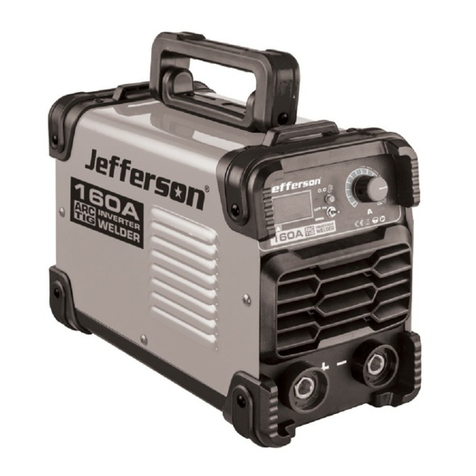
Jefferson
Jefferson JEFTARC160-230 User manual
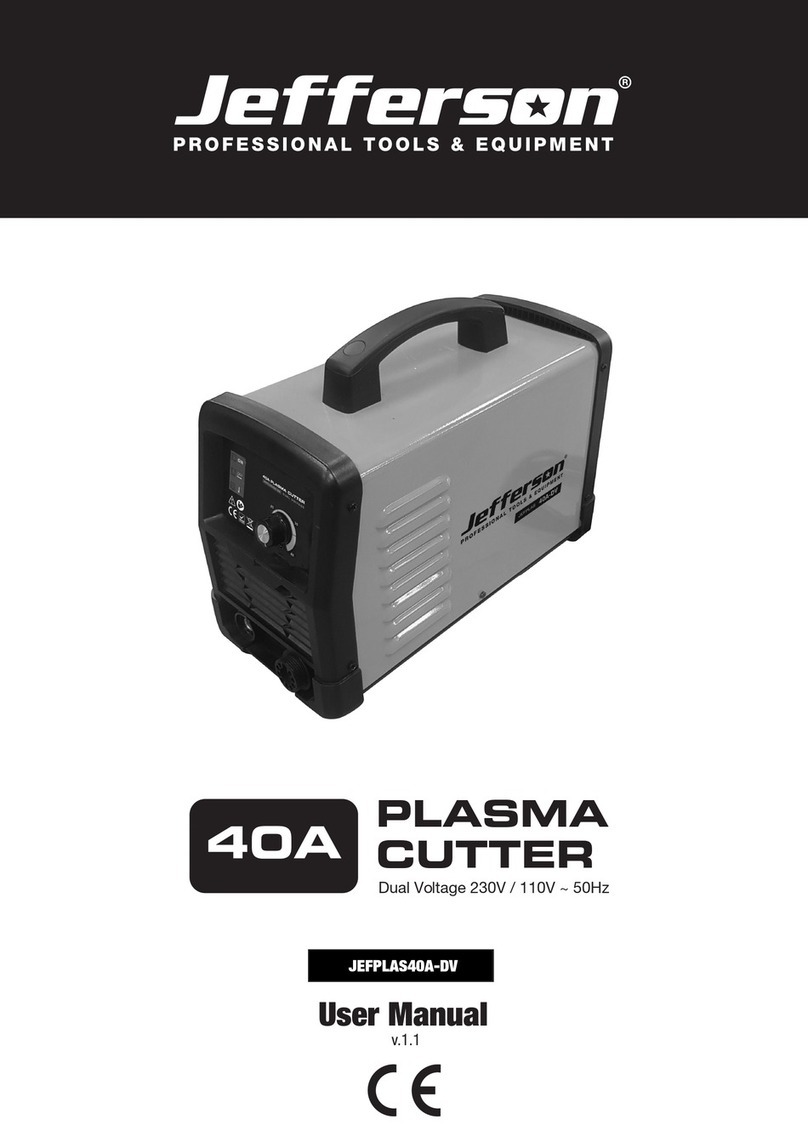
Jefferson
Jefferson JEFPLAS40A-DV User manual
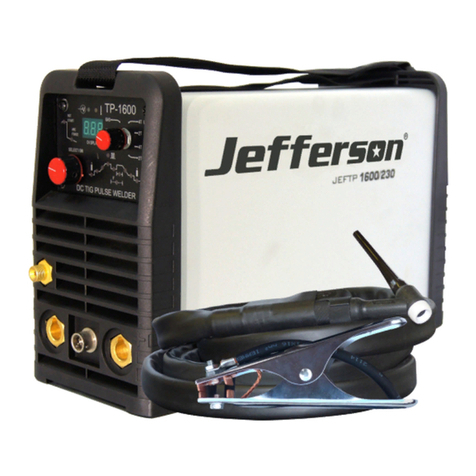
Jefferson
Jefferson TP Series User manual

Jefferson
Jefferson JEFARC140M-230 User manual
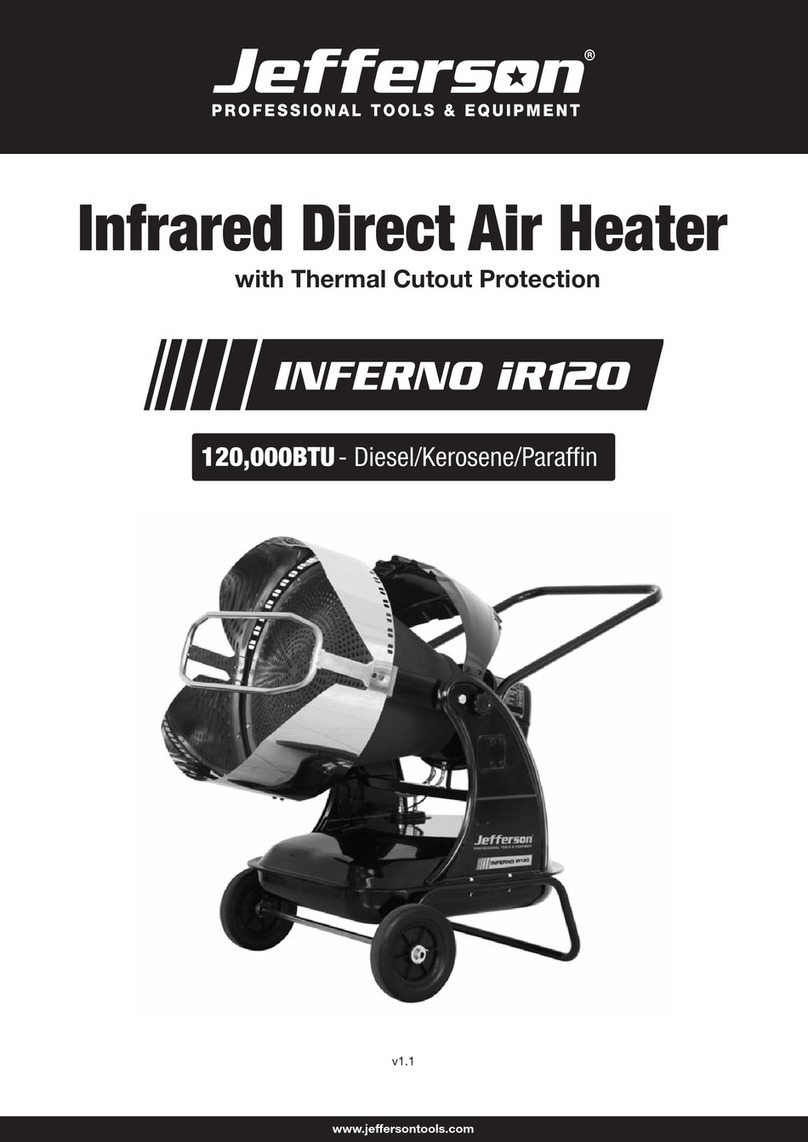
Jefferson
Jefferson INFERNO IR120 User manual
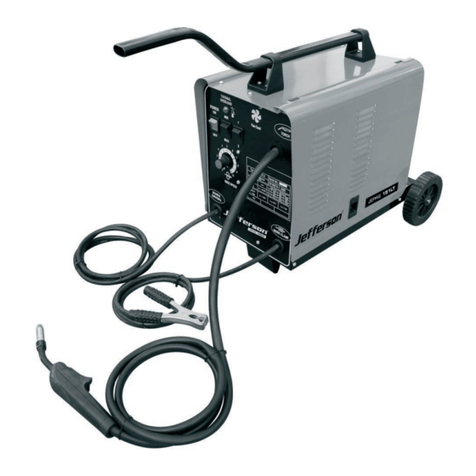
Jefferson
Jefferson JEFMIG151-A User manual
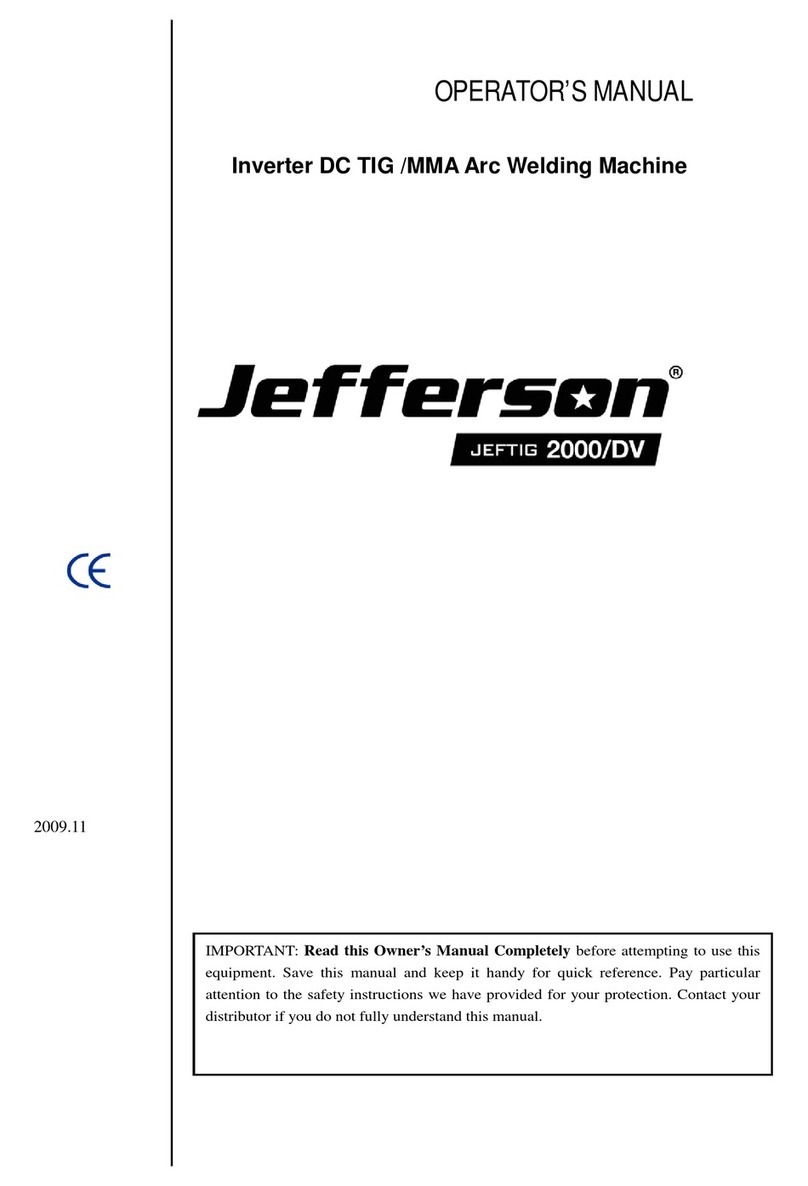
Jefferson
Jefferson JEFTIG GT Series User manual
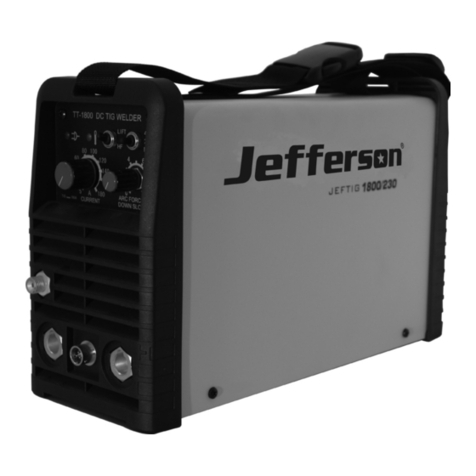
Jefferson
Jefferson JEFTIG1800230 User manual
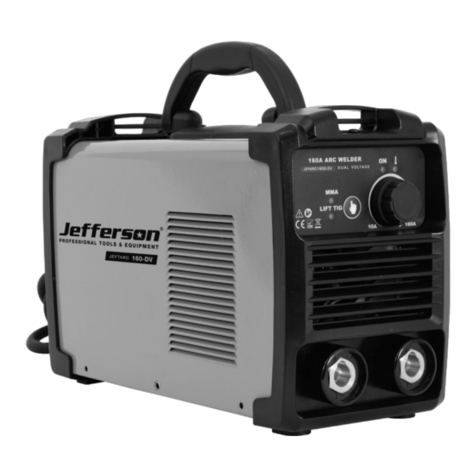
Jefferson
Jefferson JEFTARC160-DV User manual
